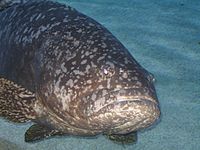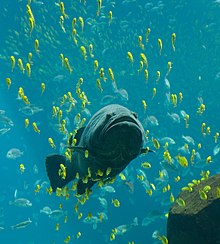Giant grouper
"Brown spotted cod" redirects here. For the Southern African fish, see brown-spotted rockcod. For the Persian Gulf fish, see Brown Spotted Reef Cod.
Not to be confused with goliath grouper.
| Giant Grouper | |
|---|---|
 | |
| Conservation status | |
| Scientific classification | |
| Kingdom: | Animalia |
| Phylum: | Chordata |
| Class: | Actinopterygii |
| Order: | Perciformes |
| Family: | Serranidae |
| Genus: | Epinephelus |
| Species: | E. lanceolatus |
| Binomial name | |
| Epinephelus lanceolatus (Bloch, 1790) | |
This giant fish is similar to the Malabar grouper, and its colour changes with age. The giant grouper has a large mouth and a rounded tail. Juveniles have irregular black and yellow markings, while adults are green-grey to grey-brown with faint mottling. There are numerous small black spots on the fins.
The first fish to undergo chemotherapy was Bubba, a giant grouper at the Shedd Aquarium in Chicago, USA.[3]


No comments:
Post a Comment